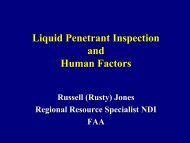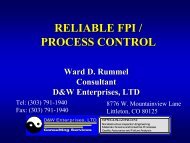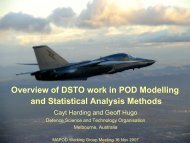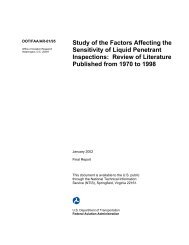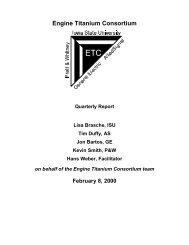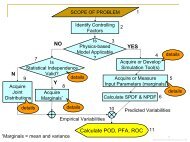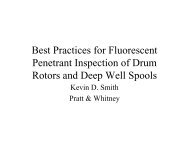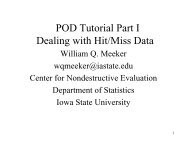Engine Titanium Consortium - Center for Nondestructive Evaluation ...
Engine Titanium Consortium - Center for Nondestructive Evaluation ...
Engine Titanium Consortium - Center for Nondestructive Evaluation ...
Create successful ePaper yourself
Turn your PDF publications into a flip-book with our unique Google optimized e-Paper software.
measured P(L) curve, and tabulate the minimum, maximum, and mean values of “b” thus obtained.<br />
We note that P(L) curves, sometimes referred to as two-point correlation functions, are of interest<br />
because they appear in a direct manner in certain models of ultrasonic attenuation and<br />
backscattered grain noise.<br />
In all of the cases examined, the grain cross-sections seen in the micrographs have roughly similar<br />
average dimensions in the X and Y directions, indicating an equiaxed grain structure. This is<br />
demonstrated in Figure 4 <strong>for</strong> the MCL method. The P(L) analysis similarly finds nearly equiaxed<br />
grain diameters. As shown in Figures 5 and 6, the two methods generally yield similar average<br />
grain diameters. When a given micrograph is analyzed, the MCL estimate usually falls in between<br />
the minimum and maximum estimates from the P(L) method. As shown in Figure 6, the average<br />
grain diameter estimate from the P(L) method tends to be about 5% below that of the MCL method.<br />
Since the grains appear to be equiaxed and the two analysis methods yield similar diameter<br />
estimates, we average over the two analysis directions [X and Y] and over the two methods [MCL<br />
and average P(L)] to arrive at an overall grain diameter estimate <strong>for</strong> each micrograph.<br />
One step in the analysis of each micrograph is the construction of a tracing showing only the true<br />
grain boundaries. When such tracings are made, so-called “twin boundaries” are intentionally<br />
excluded, since it is believed that they do not significantly contribute to attenuation and backscattered<br />
noise. Our goal is to correlate the grain diameter estimates with ultrasonic properties.<br />
Absolute errors in grain diameter estimates are believed to mainly arise from two factors: (1) the<br />
process of identifying “non-twin” grain boundaries is somewhat subjective; and (2) a given<br />
micrograph containing a few hundred grains represents only a very minute fraction of the specimen<br />
volume that is insonified in a given ultrasonic measurement.<br />
During the quarter, ef<strong>for</strong>ts were made to correlate the measured grain diameters at various billet<br />
sites with the ultrasonic attenuation values measured earlier. Figure 7 displays the attenuation<br />
values at 7.5 MHz <strong>for</strong> all measurement sites and inspection directions. Absolute attenuation values<br />
are believed to be accurate to within about +/-0.0015 N/cm or +/-0.03 dB/inch. Given this level of<br />
accuracy, one sees that at a given site in a given specimen, the ultrasonic attenuation is quite<br />
isotropic. For three of the specimens (strip coupons) the attenuation drops significantly as one<br />
approaches the OD from the billet center. For the fourth specimen (V-die-A), the attenuation<br />
increases as the OD is approached. The correlation between measured attenuation values and<br />
measured grain diameters is shown in Figure 8. Significant scatter is seen about the general trend.<br />
This is believed to be primarily due to the fact that the grain size determinations were made using<br />
only a very small fraction of the grains contained within the ensonified volume. Nonetheless, a<br />
general trend is seen of the same shape as that expected <strong>for</strong> equiaxed, untextured, pure Nickel<br />
grains.<br />
In the upcoming quarter, the ongoing analysis of all backscattered grain noise data will be<br />
completed, and figures similar to Figures 7-8 will be generated showing the dependence of noise<br />
FOM on position and its correlation with average grain diameter.<br />
Quarterly Report – January 1, 2002 –March 31, 2002<br />
print date/time: 6/6/2002 - 8:39 AM – Page 6



